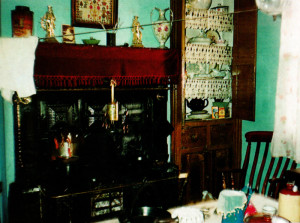
Over the years the daily routine of housework has changed out of all recognition. In the old days the first chore was to remove the ashes from the grate, thoroughly black-lead it, fetch coal and light the fire. This provided the only means of heat in the house, and was the only means of cooking. Toast was made over it, soup left simmering on it and the oven range was used for making dinner, cakes, puddings and so on.
As coal or log fires caused such a lot of dust, dusters and scrubbing brushes were the most-used appliances in the home. Tables and floors were scrubbed daily and linoleum polished. If you were lucky enough to have a carpet in the front room, this was taken up once a year and beaten over the clothes line. Stair carpet was swept regularly with a hand brush, and ‘spring cleaning’ was quite an event with furniture being moved, picture rails washed and window frames wiped.
Most houses had a white doorstep which was scrubbed with pumice stone, brasswork was polished with ‘Brasso’ and lamp shades from the oil or gas lamps had to be washed frequendy.
Mother made her own butter, jam and marmalade and would never have considered buying any. The garden supplied enough potatoes, carrots, beans and greens to ‘last us round’ and Dad spent every avail-
able minute in the garden or on his allotment. As a result Mum pickled cabbages and onions; apples, pears and plums were picked and laid out, or in the case of soft fruit bottled in ‘Kilner’ jars to provide for puddings for Sundays for the next 12 months.
Items we did not grow were picked at a neighbouring farm and botded for future use.
Does anyone remember ‘water glass’ with which we would pickle eggs? Most food was on ration and we were reminded constandy to ‘dig for victory’. Our cellar was full of
coal, fruit and vegetables. In addition to this, food from the shops was not pre packed as each item was sold separately and prepared at home. Salt was sold in blocks and cut up at home – cheese, bacon, butter, sugar etc. was all weighed up at time of sale and sold in any quantity (rationing permitting).
At Christmas time our mothers made their own cakes, puddings and mincemeat, and there were usually enough puddings to cover anyone who had a birthday early in the year.
Monday was wash day, and it lasted all day. The copper was lit up and everything in the house that could be burned was burned. Mum had just about finished and washed the floors when we got home from school at 4pm. The clothes were dried and aired in front of the fire and ironed later with the flat iron or gas iron. As clothes also were rationed, one had to ‘make do and mend’ by darning socks, turning shirt collars and repairing sheets by cutting down the centre and sewing edges together with a French seam and hem the edges.
Our houses were cold but very busy places. Knitting and sewing were done by lamp light with excellent results.
How times have changed – some for the better – but how many skills have been lost for ever?
Tony Carter








